IDEX Online Research: Polished Diamond Prices End 2008 Nearly Flat vs 2007
January 04, 09
Diamond prices nearly round-tripped in 2008. At the end of 2007, the IDEX Online Polished Diamond Price Index stood at about 116. It peaked during the summer of 2008 at around 130. By the end of 2008, it had retreated to just under 118. The graph below summarizes polished diamond prices for 2008 by month.
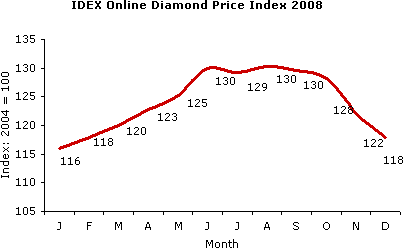
Source: IDEX Online Research
Compared to most other commodities, stocks, and housing, diamond prices held solidly in a tumultuous environment.
In fact, if a mathematical trend line is applied to historic polished diamond price trends, prices at year-end 2008 were barely below the level which a long term trend line would have predicted. The graph below illustrates this concept.
The green dotted line in the long term price trend line, while the solid red line illustrates monthly polished diamond prices in 2007 and 2008.
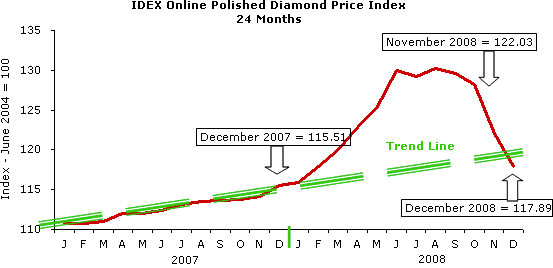
Source: IDEX Online Research
The graph above summarizes the IDEX Online Polished Diamond Price Index for the past 24 months. This graph represents the composite average asking prices of all diamonds traded at the wholesale level. The slope of the line steepened in the first half of the year, reflecting consistently higher prices – and a greater rate of price inflation – for virtually all diamond sizes. However, since the summer of 2008, polished diamond price inflation has paused – and deflation has set in – as the red line illustrates.
Prices Continue to Fall Faster for Large Stones
The graph above – the IDEX Online Polished Diamond Price Index – summarizes price trends for the aggregate market. However, not all polished diamond prices are declining at the same rate.
In the current environment, prices for stones larger than 2.0 carats are slipping more rapidly than prices for smaller polished diamonds. In fact, prices for half-carat polished diamonds rose by nearly 3 percent in December versus November, reversing a downward trend of the past several months. The price trend line for 0.5 carat diamonds is the bottom line – dark blue – on the graph below.
The graph below summarizes the long term price trends for the past two years for the seven key diamond sizes, based on the IDEX Online Polished Diamond Price Index.
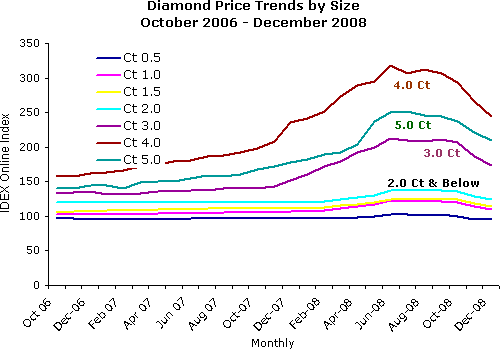
Source: IDEX Online Research
Monthly Polished Diamond Price Trends:
December 2008 versus November 2008: -3.4%
 |
On an annualized basis, December’s price decline represents a 41 percent annual deflation rate for polished diamonds. Clearly, that is an unrealistic deflation rate. The pause in inflation is beneficial to downstream participants in the diamond pipeline since their margins have been squeezed during 2008. However, the mining sector is feeling a negative impact from lower revenues due to weaker demand and reduced prices for both rough and polished stones. We believe history is a great forecaster for the future. If so, the rate of diamond price deflation will begin to moderate soon, and the longer term inflation rate will return. The IDEX Online Polished Diamond Price Index, calculated on the average daily prices during December 2008, stood at 117.89 for the month, down from 122.03 for the month of November. At the end of December, the IDEX Online Polished Diamond Price Index had slipped to 117.48, reflecting a steady, but moderate, decline during the month. The IDEX Online Polished Diamond Price Index stood at 100.00 in July 2004.
The graph below summarizes month-to-month changes in global diamond prices for the past thirteen months. Beginning in February 2008, polished diamond prices showed large gains during every month in the first half of the year.
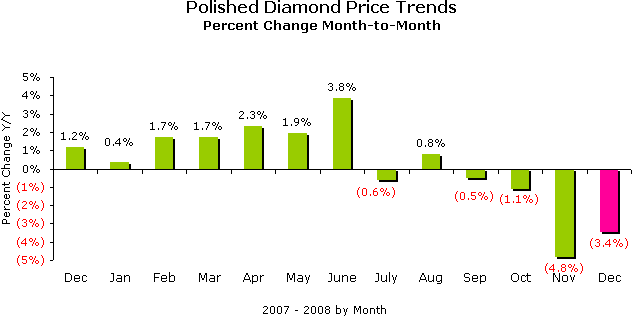
Source: IDEX Online Research
December 2008 versus December 2007: +2.1 percent
On a year-over-year basis, global polished diamond prices were 2.1 percent higher in December 2008 versus the same month a year ago – December 2007. This was the fifth consecutive month of deceleration of year-over-year price increases for polished diamonds. The current rate of polished diamond price inflation – +2.1 percent – is at the low end of the historical trend line for diamond price inflation of 3-4 percent. 
On a year-over-year basis, prices of diamonds two carats and below in size showed more moderate inflation levels, while prices for diamonds three carats and larger reflected higher price inflation rates which characterized the market for many months earlier this year. We think that polished diamond prices are likely to continue to decline, though at a more modest rate, and will dip below the historical trend line inflation rate of 3-4 percent annually, before returning to their historic trend.
The historical inflation rate of 3-4 percent annually is sustainable, in our opinion. While some forecasters are predicting a “new economy,” diamonds and diamond demand have remained more or less on the sidelines during the recent turmoil in 2008. Thus, we believe that they are more likely to remain relatively untouched in the future, once the U.S. and the global economies stabilize. Based on 50,000 or more years of demand trends, we do not expect to see any major shift in consumer demand for diamonds or other jewelry. Further, diamonds are a “green” purchase. That is clearly something that other luxury goods cannot claim.
Despite a moderating inflation rate for polished prices, it is not possible for any one supplier to act as the market monitor. As we have said many times, the polished diamond industry remains too fragmented for anyone – or any group – to hold pricing power similar to the tight-knit community of rough diamond suppliers. Thus, polished diamond prices will reflect market demand and supply. The IDEX Online Polished Diamond Price Index stood at 117.89 in December 2008 versus 115.51 in December a year ago.
The graph below summarizes the year-over-year inflation rate by month for polished diamond prices in the global market for the past thirteen months.
Comparisons are based on the daily average prices during the month versus the same month a year ago (e.g. December 2008 versus December 2007). The year-to-year comparison takes into account the seasonality of polished diamond demand and prices.
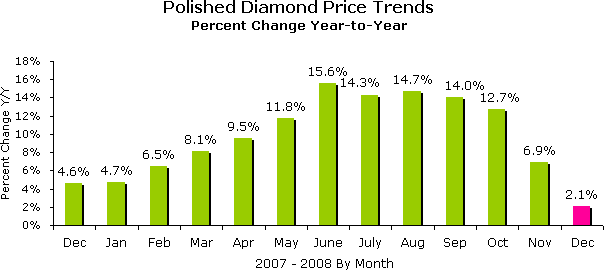
Source: IDEX Online Research
Daily Polished Prices Drifted Steadily Lower During the Month
Polished diamond prices drifted lower in December, though at a decelerating rate. There were no notable price spikes up or down during the month. The price deflation rate was orderly. After accelerating for the first half of 2008, polished diamond prices stabilized in June, and began decelerating at the end of the summer. This coincides with the slide of global financial markets as investors and merchants became more worried about the likelihood of a worldwide recession. Diamond traders found that they were unable to buy and sell diamonds at the artificially high prices reflected on some industry price lists; thus, overall asking prices declined slightly to more realistic levels. Still, there was no panic similar to that which characterized the global financial markets.
The following graph illustrates the average price of polished diamonds on a day-by-day basis for the three-month period October-December 2008.
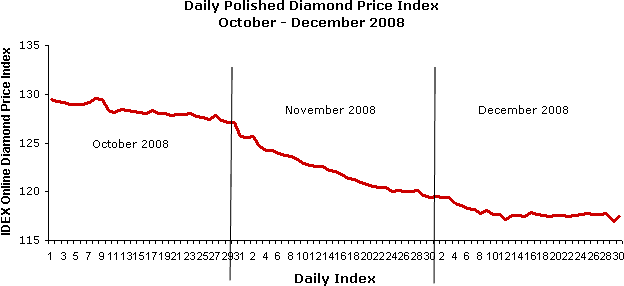
Source: IDEX Online Research
While the graph above represents an index of polished diamond prices, it is more instructive for diamantaires to understand how much – in U.S. dollars – polished diamond prices declined – or rose – during the month.
The graph below compares diamond prices for selected key diamond categories. The price comparisons are based on end-of-month prices – November 30, 2008 versus December 31, 2008.
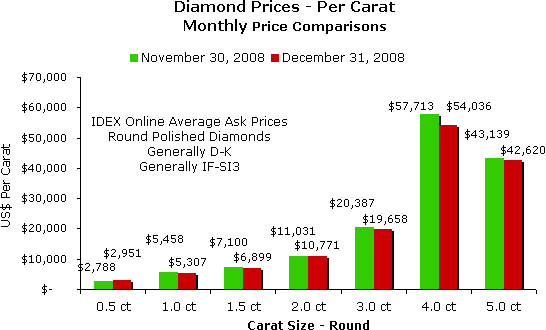
Source: IDEX Online Research
Month-to-Month Diamond Prices Decline for Most Sizes
After stabilizing for several months, month-to-month polished diamond prices have shown some decline for almost all of the key sizes. While demand had been strong in 2007 and early 2008 for large diamonds – in the 4-5 carat range – retailers are now seeing some shopper reticence as consumers buy “down.” Rather than buying the largest, fanciest stone, shoppers are willing to compromise on either quality or size. Shoppers are opting for more modest, though flashy stones, according to retail merchants’ reports. Thus, prices for these larger stones have shown a greater decline than some of the other key sizes over the past month. One interesting observation: prices for one-half diamonds rose modestly during the month. These trends support the old adage: the faster prices rise, the harder they fall on the way back down.
The graph below summarizes the price changes for key sizes of polished diamonds on a month-over-month basis: December 2008 versus November 2008. These seven stone sizes represent about 33 percent of the trading market by value.
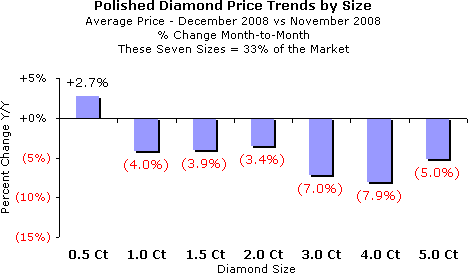
Source: IDEX Online Research
Year-Over-Year Diamond Prices for All Sizes Show Decelerating Inflation
On a year-to-year comparison, polished diamond prices rose at a double-digit rate only for three-carat and five-carat stones. In part, this is an anomaly of the math, because the fact is this: prices for larger stones are declining. However, as has been the trend for this diamond demand cycle (about 3-4 years), prices for large stones in the three-to-five carat range have shown a higher inflation rate than prices for stones two-carat and smaller stones. It is important to note that the year-over-year price inflation rate for polished diamonds is decelerating.
The graph below summarizes polished diamond prices by key sizes on a year-over-year basis: December 2008 versus December 2007. These seven sizes represent about one-third of the market, by aggregate value.
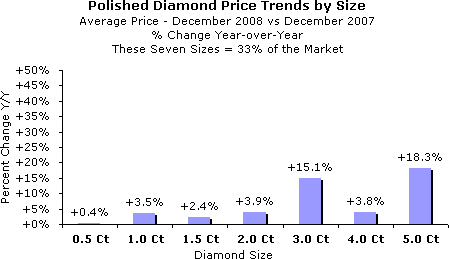 Source: IDEX Online Research |
Forecast: Diamond Prices Likely to Continue to Soften
The flames of price inflation for polished diamonds have gone cold, at least for the moment. Polished diamond prices rose at unrealistic rates in the first half of 2008, only to retreat in the second half of the year. While polished diamond prices now appear to be back on their historic trend line of inflation, we don’t look for prices to stabilize soon. There simply is too much uncertainty related to the global economic situation. Further, the natural cycle calls for diamond prices to continue to decline, though perhaps at a slowing rate, before recovering to their historic trend line.
As we noted last month, if the diamond markets truly operate on the basis of capitalism, then demand and supply should help stabilize diamond prices as they retreat toward their historic inflation rate. Unfortunately, life doesn’t work that way. For example, oil was unrealistically priced at $140 per barrel in mid-2008; it has now fallen to near $40 per barrel. Neither of these prices reflect true supply and demand, which some analysts see as stabilizing at $60-70 per barrel. Likewise, diamonds could drop to unrealistically low prices before stabilizing and recovering sometime in 2009. While capitalism – and its inherent supply and demand – isn’t perfect, no one has come up with a better, more successful long term alternative.
The IDEX Online Diamond Price Index
The IDEX Online Diamond Price Index is a real-time index derived from actual asking prices in the global diamond industry. The IDEX Online Diamond Price Index objectively reflects price trends as they happen. The Diamond Index and Diamond Drivers were formulated following comprehensive research and analysis of the IDEX Online inventory database, aggregated since 2001. Research and development were conducted in cooperation with Dr. Avi Wohl, Senior Lecturer of Finance at the faculty of Management, Tel Aviv University, Israel.
Additional information is available from IDEX Online Research. The e-mail address is diamondprices [at] idexonline [dot] com.